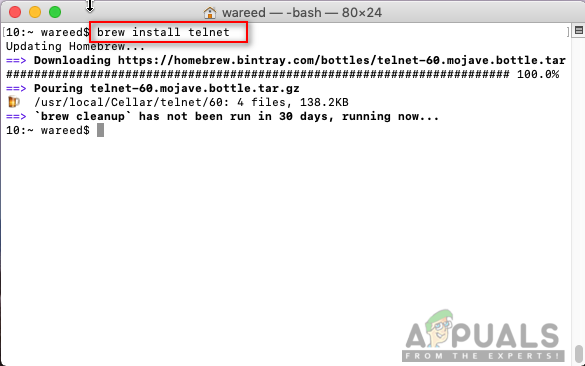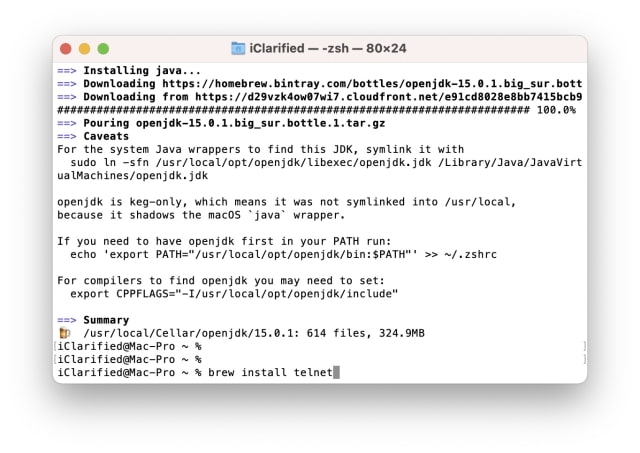

- WHERE IS TELNET ON MAC OS MAC OS X
- WHERE IS TELNET ON MAC OS INSTALL
- WHERE IS TELNET ON MAC OS DOWNLOAD
- WHERE IS TELNET ON MAC OS WINDOWS
Open Windows Start menu > Type "Control Panel" > Press Enter > “Programs” > "Programs and Features" > Turn Windows features on or off > Select "Telnet Client" > Press “OK" Install-WindowsFeature -name Telnet-Client If you want to use the graphical user interface you need to: If you want to enable Telnet via the command line, open the Command Prompt with elevated privileges (“as Administrator”) and run the following command:ĭism /Online /Enable-feature /FeatureName:TelnetClientĪfter you’ve put this in, Telnet will be ready to use to check your ports.Īlternatively to Command Prompt, you can use the following PowerShell command to achieve the same result: Enabling telnet client through Command Prompt: In order to turn Telnet on, you need to use the command line or the graphical interface of your computer. ‘telnet’ is not recognized as an internal or external command, operable program or C:\> If you try to use telnet without turning it on first, you’ll receive a message like:

Turning it on will help you to run the required diagnostics and check if a port is open. One of the most important things to remember is that Telnet is disabled by default in Window’s settings, so you need to turn it on before you can do anything. Enabling telnet client in Microsoft Windows operating systems Though most users opt to work with graphical interfaces, Telnet is one of the simplest ways to check connectivity on certain ports. Telnet utility allows users to test connectivity to remote machines and issue commands through the use of a keyboard. We will use the term “Telnet” mostly in the context of the telnet client software. The word “Telnet” also refers to the command-line utility “telnet”, available under Windows OS and Unix-like systems, including Mac, Linux, and others. In a nutshell, Telnet is a computer protocol that was built for interacting with remote computers. In this article we’ll break down how Telnet can be used to check ports on Windows 10, Windows Server 2016, 20. Telnet allows the user to test individual ports and see whether they are open or not. However, one of the most efficient ways is to use the network protocol Telnet. configure -disable-servers -disable-dnsdomainname -disable-hostname -disable-ping -disable-ping6 -disable-rcp -disable-rexec -disable-rlogin -disable-rsh -disable-logger -disable-talk -disable-tftp -disable-whois -disable-ifconfig -disable-tracerouteħ - For the installation I don't use make install, I preferred to copy only the necessary files to /usr/local/bin/, as below:Ĩ - Now you can use telnet and ftp as you like.Many people find the challenge of checking if a port is opened to be too complex. As you can see below, the configure line disable all servers and others programs: As I don't like to overwrite applications that are already come in OS X, I selected exactly what I want to install, in my case, ftp and telnet clients. I have even noticed that many are already installed in the Mojave.
WHERE IS TELNET ON MAC OS DOWNLOAD
You can use curl to download the inetutils, as below:Ĥ - Enter the inetutils-1.9.4 folder with:ĥ - Configure the package with the following:Īs I said in the introduction to this article, the gnu-inetutils package contains many client and server applications.

Access the terminal / shellĢ - Download the latest version of the gnu-inetutils package, in my case inetutils-1.9.4, at:
WHERE IS TELNET ON MAC OS MAC OS X
The entire procedure has been reviewed and tested with Mac OS X Mojave and is running 100% correctly.ġ - It is required that you have XCODE installed and configured to be able to compile the packages. So, I once again followed the step-by-step of my old article and installed exactly what I needed, telnet and ftp.
WHERE IS TELNET ON MAC OS INSTALL
Well I returned to my old article and I noticed that some friends of the forum suggested using ports or by homebrew, which are two valid solutions to solve the problem, but I personally do not like to use them, as they’ ll install telnet and ftp, and will overwrite several programs that have already come in the default installation of Mac OS X. With the release of Mac OS X Mojave, I realized that telnet and fpt have not been installed again, as I use a lot this system tools to development and test systems and networks. Last year I wrote an article about installing telnet and ftp on Mac OS X High Sierra, you can read the article at the link below:


 0 kommentar(er)
0 kommentar(er)
